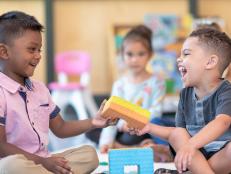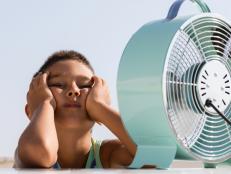Five Hacks for Cleaning Your Child’s "Lovey"
Follow these tips to freshen up your kid's most beloved stuffed animal or blanket.


Catherine Falls Commercial
Every kid has that one special belonging they can't live without. Whether it's a ratty stuffed animal or a tattered blanket, your child’s lovey can help calm them when they are scared, bring them comfort during new situations, and help lull them to sleep at night. Yes, those loveys are special — but WOW do they get smelly and dirty. Not the sweet smell of your little one, but a full-on stink that can be pretty gross.
However, you can’t just toss their beloved into the washing machine and hope it comes out intact (not to mention the tears if your child is separated from their lovey for too long). Since loveys take a little extra care when it comes to cleaning, here are five hacks that will get your child’s lovey looking and smelling brand new.
1. Spread Out the Washes
To help your child’s lovey stand the test of time — and ensure your little one isn't separated from their lovey for too long — you may want to spread out the deep cleans. Spot cleanings between washings can help. Just use warm water and gentle dish soap, then leave it in the sun to dry. However, if your child is sick, you’ll want to make sure their lovey gets a good cleaning with hot water and detergent once they are feeling better.
2. Use the Gentle Cycle
Instead of just tossing the lovey into the washing machine where it could end up damaged, start by placing it in a pillowcase or a delicates laundry bag. This will help protect it from getting frayed or losing stuffing in the wash. Spot clean before, use a gentle soap with warm water, and turn on the delicate cycle. To be extra cautious, line-dry the lovey and try to skip the dyer if you can. If the lovey is a plush toy, gently push the stuffing back into place while it is still damp.
3. Baking Soda Bag
For larger loveys (or the ones that might not survive the gentle cycle), baking soda is a great option. Grab a paper bag and toss in some baking soda. Put the lovey inside and give it a gentle shake. Then, let the lovey sit for 30 minutes to an hour, take it out, and give it a good dusting. The baking soda will freshen up your child’s most prized possession while keeping fabric or stuffing intact.
4. Make Your Own Cleanser
For kids who tend to put their toys in their mouth—so, basically all kids—you can easily clean their lovey in the washing machine or hand wash it in a baking soda and vinegar mixture. Don’t worry about the vinegar smell because as the fabric dries, that scent will dissipate. Allowing the lovey to dry in the sun can also work wonders for smells!
5. Get Creative With Separation
Sometimes, you have to get creative with how you approach washing the one thing your child can’t be separated from. You can have a stash of backup loveys for your child to cycle through or wash it while your child is distracted eating or playing. You can even have your child help you clean their lovey. They can help with the hand washing, then you can take over and use a hair dryer to finish up the job — or opt for a very short cycle in the dryer. Just be sure to use dryer balls so their lovey doesn’t lose its shape!















